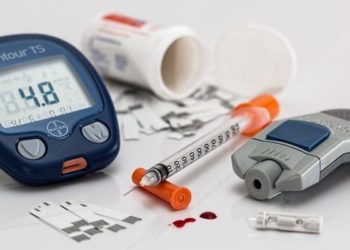Tirzepatide improves glycemic control and weight loss in patients with type 2 diabetes
1. Tirzepatide was superior to placebo with regard to changes in HbA1c, serum glucose, body weight loss, and proportion of patients achieving HbA1c targets of less than 7.0%.
2. Compared to placebo, the proportion of adverse events with tirzepatide were mildly elevated.
Evidence Rating Level: 1 (Excellent)
Study Rundown: In many patients with type 2 diabetes, management with diet and exercise may be inadequate to achieve treatment goals. Agonism of GLP-1 and glucose-dependent insulinotropic polypeptides (GIPs) receptors have shown efficacy for glycemic control and weight loss. However, the effects of dual-agonism have only been minimally studied. This randomized controlled trial aimed to assess the efficacy, safety, and tolerability of tirzepatide, a dual GIP and GLP-1 receptor agonist, versus placebo, in patients with inadequately controlled type 2 diabetes. Primary outcome for this study was mean difference in HbA1c from baseline to 40 weeks of randomization, while secondary outcomes included change in serum glucose and body weight, and proportion of patients with HbA1c <5.7% and <7.0%. According to study results, all doses of tirzepatide were superior to placebo with regard to the aforementioned primary and secondary outcomes at 40 weeks. Majority of the medication-induced side effects were mild to moderate in nature, with no treatment-delated deaths. Although this study was well constructed, it could benefit from a longer follow-up given the chronic and relapsing nature of type 2 diabetes and bodyweight changes.
Click to read the study in The Lancet
Relevant Reading: Tirzepatide versus Semaglutide Once Weekly in Patients with Type 2 Diabetes
In-depth [randomized controlled trial]: Between Jun 3, 2019, and Oct 28, 2020, 705 individuals were assessed for eligibility across 52 clinical centers in India, Japan, Mexico, and the USA. Included patients were ≥18 years of age with inadequately controlled type 2 diabetes on exercise and diet. Altogether, 478 patients were randomized (121 to tirzepatide 5 mg, 121 to tirzepatide 10 mg, 121 to tirzepatide 15 mg, and 115 to placebo) and 428 completed the study. Mean age among enrolled patients was 54.1 years (standard deviation [SD] 11.9), while mean HbA1c was 7.9%. The average BMI was 31.9 kg/m2.
The primary outcome of mean treatment difference in HbA1c, compared to placebo, was dose-dependent: -1.91% for tirzepatide 5 mg, -1.93% for tirzepatide 10 mg, and -2.11% for tirzepatide 15 mg (p<0.0001 for all doses vs. placebo). All three doses of tirzepatide were superior to placebo, from baseline to week 40, with regard to mean change in HbA1c (1.87% decrease for tirzepatide 5 mg, 1.89% decrease for tirzepatide 10 mg, 2.07% decrease for tirzepatide 15 mg, 0.04% increase for placebo), serum glucose, body weight, as well as proportion of patients with HbA1c <5.7% (31-52% with tirzepatide vs. 1% with placebo) and HbA1c <7.0% (87-92% with tirzepatide vs. 20% with placebo). Compared to placebo, the proportion of adverse events with tirzepatide were slightly elevated (nausea: 6% vs. 12-18%, diarrhea: 8% vs. 12-14%, and vomiting: 2% vs. 2-6%). However, there were no medication-related deaths; only one death occurred in the placebo group. Overall, findings from this study demonstrate rigid evidence for tirzepatide use to achieve glycemic control in patients with lifestyle-resistant type 2 diabetes.
Image: PD
©2021 2 Minute Medicine, Inc. All rights reserved. No works may be reproduced without expressed written consent from 2 Minute Medicine, Inc. Inquire about licensing here. No article should be construed as medical advice and is not intended as such by the authors or by 2 Minute Medicine, Inc.





